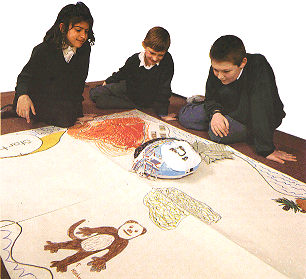
|
Feedback Form

ROAMER CRUSOE
 Dot
Ginn has been working on several Roamer design projects, here she reports
on one of them.
Dot
Ginn has been working on several Roamer design projects, here she reports
on one of them.
I have been working with small groups of children at Southmead Primary School, Wimbledon, using the Roamer as part of their project work.
The Roamer can be used as an integral part of most Primary school projects. Its function in the classroom can address such subjects as art, design, mathematics and information technology.
The children, ages 10 and 11, were doing a project on Energy with reference not only to power sources - electricity, wind and solar energy etc. but also our own body's energy needs.
The children considered what was necessary to keep us alive, fit and well and a question was put to them: "What would you need to survive if left alone on an island?" A discussion followed and the conclusions reached were: We would need food, water, shelter from the weather and protection from wild animals.
A task was then given to a small group, to design a floor game on a large piece of paper. Using the Roamer as a castaway shipwrecked on the island, his aim was to find warmth, shelter, food and drink before nightfall. It was also stressed that there would be dangers on the island to be avoided.

The children discussed this and decided that the Roamer could use large leaves to keep himself warm, fruit trees would provide food, there would be coconut milk to drink and caves in which to shelter. The dangers were an active volcano, a swamp and an angry monkey.
The children then sat down and planned their map of the island. They constantly had to be aware of the size of the Roamer and its unit of distance when planning each part of the map. Overheard snippets of conversation included "Where should the swamp be?" "How big can it be?" "If the Roamer goes forward 2 it will end up in the swamp, make the swamp smaller!"
Having planned the map and the course of the Roamer, the children then coloured it in, cut out paper shapes for the leaves and fruit and made a cave out of a suitable sized cardboard box covered in grey paper. They also designed and decorated a Roamer Jacket to look like a shipwrecked sailor in ragged clothes. The game was given the name "The Island Mission". It was now up to the group to explain the aim of the game to the class.
The children experienced a number of skills in this project - how to fulfil a design brief, how to plan and be prepared to alter plans, and to be aware of constant factors such as the Roamers units of distance when making plans. They had to share ideas, discuss options and work and cooperate together. The game could have been made quite simply but the children understood that it would be more attractive and exciting to play if it were colourful and interesting to look at.
Those who played the game had to test their powers of estimation and their understanding of angles and directional sense were tried. Some children having mastered the game modified their program by changing the "wait" time or angle to improve on the amount of time it took to complete the game.
A further possibility is that the map could be gridded so that the children could plot coordinates for the Roamer to pass through to get home.
Teacher's try many ways to encourage children to explore and learn, to be constructive and creative. The Roamer can marry artistic creativity with mathematical and technological skills in an enjoyable way which I find most challenging.
| Back |
|---|